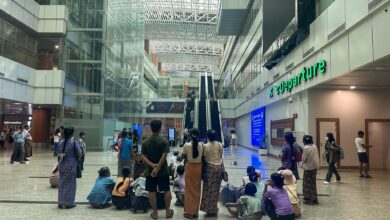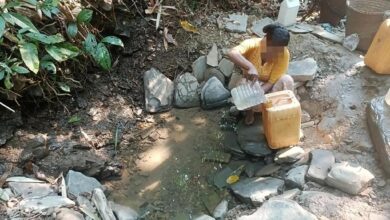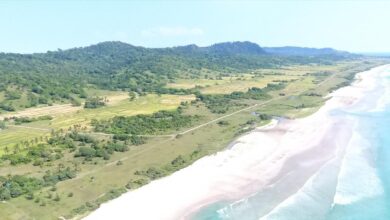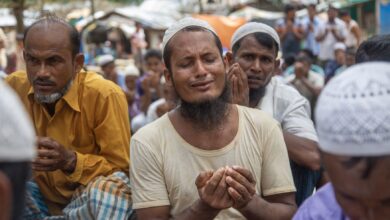
Faced with growing criticism over their push to normalise relations with Myanmar’s illegal military junta, United Nations agencies have embarked on an effort to justify their actions. Using social media, they have deployed infographics and other tools to demonstrate just how indispensable international aid organisations are in a country wracked with conflict.
On October 3, for instance, the Myanmar Information Management Unit (MIMU), which operates under the UN Office for the Coordination of Humanitarian Affairs (OCHA), published a map that looks truly impressive. It professes to show areas covered by “projects under implementation” by international nongovernmental organisations (INGOs) and the Red Cross.
In some places, such as Chin and Kayin states, there is barely a speck of white in the sea of yellow that indicates the presence of such projects. Even Sagaing and Magway regions, where the military’s ongoing war against civilians opposed to its rule has been most intense, have about 80% coverage.
Another graphic tweeted by OCHA Myanmar three days later claims that its “partners reached 3.1 million people with assistance at least once in the first half of 2022,” despite “access challenges” and an 80% shortfall in funding for its Humanitarian Response Plan. Again, a strong showing considering Myanmar’s near-total collapse since last year’s military takeover.
A closer look, however, reveals that these figures do not provide an accurate picture of the actual situation on the ground.

Consider this disclaimer from MIMU: “This map shows presence of organisations and does not indicate the volume of assistance, the number of beneficiaries, or the extent to which needs are met or unmet.” In other words, it tells you almost nothing about the real extent of aid delivery.
And then you have to wonder what OCHA Myanmar means when it says that its partners have reached 3.1 million people “at least once” in the first half of this year. This begs the question: How many of these people received aid only once? And was that enough to make a real difference in their lives?
Once you begin to pull on these threads, even more questions come to mind. For example: What kinds of assistance were provided? How was it decided who would receive aid? And what role did the junta play in the decision-making and delivery processes?
In short, it is highly misleading to release facts and figures that do more to obscure than inform. Without context, and without meaningful details, this amounts to little more than a slick PR exercise that does an enormous disservice to ordinary citizens under constant attack from their would-be rulers.
With more than a million people displaced by the military’s “clearance operations” around the country and tens of millions more driven into poverty by the junta’s callous disregard for everything except its own claims to power, Myanmar deserves answers about how international aid is being—and will be—distributed in future.
If UN agencies are genuinely interested in winning the trust of Myanmar’s people, they need to fill in some of the blanks in the information that they have so far provided.

It is worth asking, for instance, how much international aid has reached parts of Sagaing and Magway regions and Chin, Kayah, and Kayin states devastated by the military’s air and ground assaults. Have UN aid agencies or their partners done needs assessments in these areas? If so, when will they publish this information?
Also, what kind of aid has been provided in these and other parts of the country? And how has it met actual needs?
There are also many who would like to know if the UN has engaged in serious discussions with the National Unity Government, ethnic armed groups, and local civil society organisations on the territories not controlled by junta about what role they could play in delivering aid. If so, have they reached any agreements or allocated any funds?
On the subject of money—have UN agencies and INGOs been exchanging foreign currencies into kyat at the rate set by the regime? Since this would be putting hard currency into the hands of the country’s generals, has any effort been made to assess the impact this would have on their ability to commit crimes against the people of Myanmar?
Is it true, as some have reported, that UN agencies that have signed deals with the regime have pressured their INGO partners to do the same? And have they also agreed to share information about their partners’ projects with the junta?
Given that the UN’s Humanitarian Response Plan for Myanmar is operating on only 20% of its budget for this year, it seems pertinent to ask how much of this money has been spent on UN personnel and INGO expat staff who have been outside of the country since the coup. Are they receiving extra compensation, in the form of lodging costs, per diems, family allowances, and so on, in addition to their regular salaries? If so, are these expenses being paid for from the $169m that the UN says it has at its disposal to assist Myanmar’s most vulnerable citizens?
What assurances can the UN offer that the junta won’t be able to weaponise aid, by directing it into areas under its control while denying it to those living in parts of the country where it faces resistance? And considering the dramatic spike in corruption since the coup, are there any guarantees that money meant to assist the poor won’t end up being misdirected towards those who don’t need it at all?

These are just some of the many questions that could be asked. But I leave it to a colleague with more than 20 years experience as a Myanmar national working in the aid sector to ask the one that should matter most to UN agencies seeking to return to business as usual in her country.
“Do you know,” she said, addressing “international colleagues” who might not want to hear what she has to say, “that in the eyes of the general public and most civil society organisations, anyone who deals with this illegitimate regime is seen as an accomplice in its many human rights abuses, including its killing of innocent children?”
The UN agencies clearly care enough about their image to make some attempt to justify their decision to cooperate with a regime that most in the country openly reject (even at great risk to their own lives). But if they believe that graphs and maps with incomplete data will be enough to convince anyone that they are a force for good, they are seriously mistaken.
Igor Blazevic is a prominent human rights campaigner based in the Czech Republic. He is a lecturer at Educational Initiatives, a training program for Myanmar activists, and a senior adviser with the Prague Civil Society Centre.



